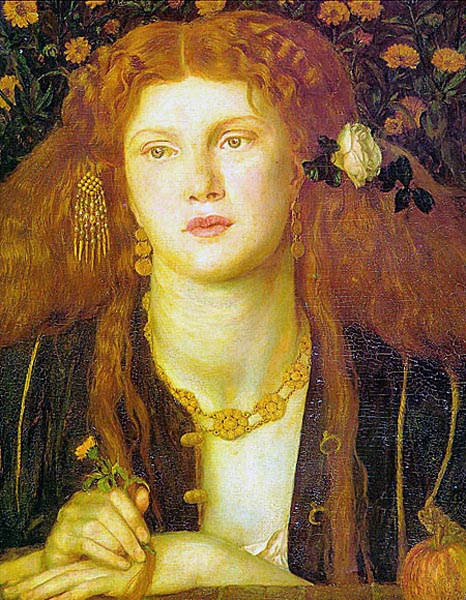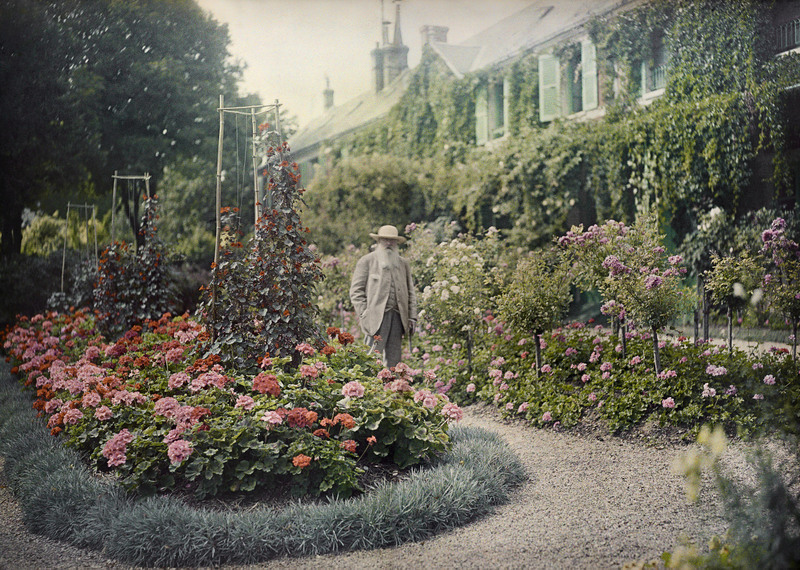Review by Kim Clayton-Greene of The Cult of Beauty: The Aesthetic Movement 1860-1900
The Cult of Beauty: The Aesthetic Movement 1860-1900
The Victorian and Albert Museum, London 2 April – 17 July 2011
Reviewed by Kim Clayton-Greene

‘The Cult of Beauty’, brings together some of the finest objects and works of art produced by those artists and craftsmen who revolutionized late nineteenth-century British art and society. As the introductory wall text states, these men and women were united by ‘the desire to escape the ugliness and materialism of the age and find a new beauty’. The exhibition begins by demonstrating the way this ‘new beauty’ manifested itself in all realms of art and life by placing immediately opposite the entrance door Frederic Leighton’s sculpture The Sluggard (1851) (Fig. 1), Edward Burne-Jones’s gilded, ornamental A Peacock (1886) (Fig. 2), Thomas Jeckyll’s sunflower Andirons (c.1876) (Fig. 3) and various ceramics and works on paper.
The artists associated with the Aesthetic Movement sought to create art and objects that existed in order to be beautiful, free from Victorian moral boundaries and artistic and social codes, which the Aesthetes perceived as almost medieval-like constraints. The walls of exhibition space are painted in deep, lustrous colours, onto which are projected light stencils in complementary colours that both demarcate the components of each section and allude, in a contemporary way, to the interior design philosophies promoted by the Aesthetes. These philosophies are explored in a display of the meticulous interior and exterior designs by the leading architects and designers of the movement, notably Philip Webb and George Aitchison. Among the best are E.W. Godwin’s luminous plans for James McNeill Whistler’s house at 7 Lindsey Row, Chelsea (Fig. 4). These are complemented by Whistler’s Design for Wall Decoration at Aubrey House London (1873-4) (Fig. 5) that reveals how he would prepare walls as he did a canvas, allowing semi-transparent layers of colour to give life to each other.
Interior design and decoration features throughout the exhibition: furniture, the products of Liberty’s store, and wallpaper and tile designs by Morris and Crane are shown in every room. However, in the two instances where attempts have been made to recreate period interiors, the results are disappointing. The first is a recreation of Dante Gabriel Rossetti’s bedroom at Tudor House, based on the watercolours of the house by Rossetti’s studio assistant Henry Treffry Dunn (Fig. 6) and the catalogue of the sale of Rossetti’s household goods in 1882. Unfortunately, the result is a tiny space viewable only through three small rectangular portals that prevent the paintings and objects displayed within to be seen in their entirety. The second, an attempt to reproduce Whistler’s Harmony in Blue and Gold: The Peacock Room (1876–7), designed for the London home of the Liverpool shipping magnate Frederick Leyland and now permanently installed in the Freer Gallery in Washington (Fig. 7), consists of a tall cylindrical structure in the centre of the penultimate room on the inside of which are moving projections of the Peacock Room’s four walls. The images are pixelated and faded, and their movement is unsettling if you try to look at the details. For visitors unfamiliar with the Peacock Room the display is rather uninformative, while those who know the original will have their memories of the vibrancy of what is Whistler’s glittering magnum opus diminished.
Much more successful is the way the exhibition tackles a range of broad themes. The craze for Japonisme, particularly Nankin Porcelain, and the influence of Japanese design, fashion and artistic technique is particularly well done (Fig. 8). Original Nankin porcelain owned by Whistler and Rossetti, who together pioneered the craze for collecting ‘Old Blue’ in the 1860s, is displayed alongside Whistler’s illustrations made for the publication of Sir Henry Thompson’s important collection of blue and white wares formed with the aid of the art dealer Murray Marks. Whistler’s Pink and Grey: Three Figures (Fig. 9) in which the perspective and the group of figures refer to Whistler’s love of Japan, hangs next to Godwin’s delicate ebonized Sideboard (Fig. 10) an example of the ‘Anglo-Japanese’ style developed by the Aesthetes, demonstrating how the Aesthetic interest in Oriental taste manifested itself across art and design.
Aesthetic ideals of feminine beauty are handsomely explored through a wall of portraits at the beginning of the exhibition that introduces the viewer to the type of female beauty that the Aesthetes idealized, including the sultry and sensual Bocca Baciata (1859) of Dante Gabriel Rossetti (Fig. 11) and Pavonia (1858) of Frederic Leighton (Fig. 12) that exemplify the eroticism and evanescent beauty that so attracted the Aesthetes.
The later stages of the exhibition explore how the Aesthetic Movement was transformed after it became the lifestyle choice of many rather than the practice of a few. A stunning of period dress and jewellery accompanied by a wall of portraits that mirrors the earlier example in the exhibition, illustrate how ‘Artistic Dress’ became a signifier of taste that many were keen to adopt. Among the portraits of beauties and dandies by Millais, Watts and others, Frederick Sandys’ Sir William Anderson Rose (1875) (Fig. 13) stands out because its subject, a merchant, shows how the Aesthetic Movement traversed the social strata as it grew in popularity and its pictorial style emphasizes a concern for the holistic beauty of the art work.
This is followed by a display of the works produced by Aesthetic craftsmen in collaboration with major manufacturers, such as Shoolbred & Co., Morris & Co. and Gillow & Co. The standout work here is Thomas Jeckyll’s Fireplace Surround (after 1873) (Fig. 14), manufactured in collaboration with Bernard, Bishop & Barnard and decorated with Japanese ornamentation and naturalistic elements from English flora and fauna.
A beguiling aspect of ‘The Cult of Beauty’ is its incorporation of the satirical responses to the movement that emerged in the popular press. Humorous cartoons by George Du Maurier and others mock the Aesthetes and their way of life. The Aesthetic man is lampooned as effeminate in Du Maurier’s ‘Intellectual Epicures’ (1878) (Fig. 15) and chastised for his disregard of ordinary values and his self-indulgent pursuit of taste in Du Maurier’s ‘Aptly Quoted from the Advertisement Column’ (1877) (Fig. 16). Oscar Wilde, who through his writing, dress, social life and associates, became the figurehead of the Aesthetic movement in its later years, was particularly hounded by satirists and social commentators, as in Linley Sambourne’s Punch cartoon ‘Fancy Portrait no. 37: Oscar Wilde’ (1881)(Fig. 17). In the final stages of the exhibition we are told that the downfall of Wilde in 1895 was linked to the waning popularity of the movement at the turn of the century. Those who had condemned Wilde and the Aesthetes’ way of life saw in his criminal prosecution proof that the Movement provoked social degeneration. Yet the intensity of this opposition was also testimony of the extent to which the Aesthetic movement succeeded in its aims, best expressed by Lord Henry Wotton in Wilde’s The Picture of Dorian Gray: ‘I believe that if one man were to live out his life fully and completely, were to give form to every feeling, expression to every thought, reality to every dream – I believe that the world would gain such a fresh impulse of joy that we would forget all the maladies of medievalism…’. The Aesthetes were committed in their dedication to beauty and as this sumptuous exhibition in the V&A reveals their enduring legacy speaks of the power of beautiful art.
© Kim Clayton-Greene 2011
Image Slideshow
[nggallery id=13]
[NB Click on the thumbnails to view larger versions. If you are reading this in an email you will need to follow the ‘View the latest post at’ link to the MAN website to view the show properly]
List of images, in order of text reference
1.
Frederic Leighton
The Sluggard
1885
Bronze
Tate, London
2.
Edward Burne-Jones, Edward Coley (maker)
The Peacock
1886
The Victoria and Albert Museum, London
3.
Thomas Jecykll, Bernard, Bishop & Bernard (maker)
A Pair of Sunflower Andirons
c. 1876
Brass
The Birkenhead Collection
4.
E. W. Godwin
Design for ‘The White House’ and studios, for the artist James McNeill Whistler
1877
Pen and ink, ink wash, pencil and watercolour
The Victoria and Albert Museum, London
5.
James McNeill Whistler
Design for Wall Decoration at Aubrey House, London
c. 1873-4
Charcoal and gouache on brown paper
Hunterian Art Gallery, University of Glasgow, Glasgow
6.
Henry Treffry Dunn
Rossetti’s bedroom at Cheyne Walk
c. 1882
watercolour on paper
Walker Art Gallery, Liverpool
7.
James McNeill Whistler
Harmony in Blue and Gold: The Peacock Room
1876–7
Interior decoration and mural
Freer Gallery of Art, Washington DC
8.
Ginger Jar
Kangxi period, 1662-1722
Porcelain, decorated in underglaze cobalt blue
Victoria and Albert Museum, London
This piece was owned by James McNeill Whistler and in same image on the right
Vase
Kangxi period, 1662-1722
Porcelain, decorated in underglaze cobalt blue
Victoria and Albert Museum, London
This piece was owned by Dante Gabriel Rossetti
9.
James McNeill Whistler
Three Figures: Pink and Grey
1868-78
Oil on canvas
Tate, London
10.
E. W. Godwin
Sideboard
1867
Ebonised wood with silver-plated fittings with embossed Japanese leather paper
Victoria and Albert Museum, London
11.
Dante Gabriel Rossetti
Bocca Baciata
1859
Oil on Canvas
Museum of Fine Arts, Boston
12.
Frederic Leighton
Pavonia
1858
Oil on canvas
Private Collection
13.
Frederick Sandys
Sir William Anderson Rose
1875
Coloured chalks on buff paper laid down on board
Ackland Art Museum, North Carolina
14.
Thomas Jeckyll, Barnard, Bishop & Barnard (maker)
Fireplace Surround
after 1873
Cast brass
Victoria and Albert Museum, London
15.
George Du Maurier
‘Intellectual Epicures’, illustrated in Punch
1878
Victoria & Albert Museum, London
16.
George Du Maurier
‘Aptly Quoted from the Advertisement Column’, illustrated in Punch
1877
Victoria & Albert Museum, London
17.
Linley Sambourne
‘Fancy Portrait no. 37: Oscar Wilde’, illustrated in Punch
1881
British Library, London






Bravo. How utterly novel. A review that actually mentions some of the objects (the show being in a museum of applied art not a gallery of fine art.)Most other reviews obligingly repeat the V&A’s out of date views then follow the money – fine art.
Surely the trite ‘art for art’s sake’ cannot apply to functional objects – as their primary purpose is function? Ruskin and the V&A don’t understand that Decorative Art is dissociated from Fine Art; Wilde never designed anything. Lets listen to what the downtrodden designers had to say.